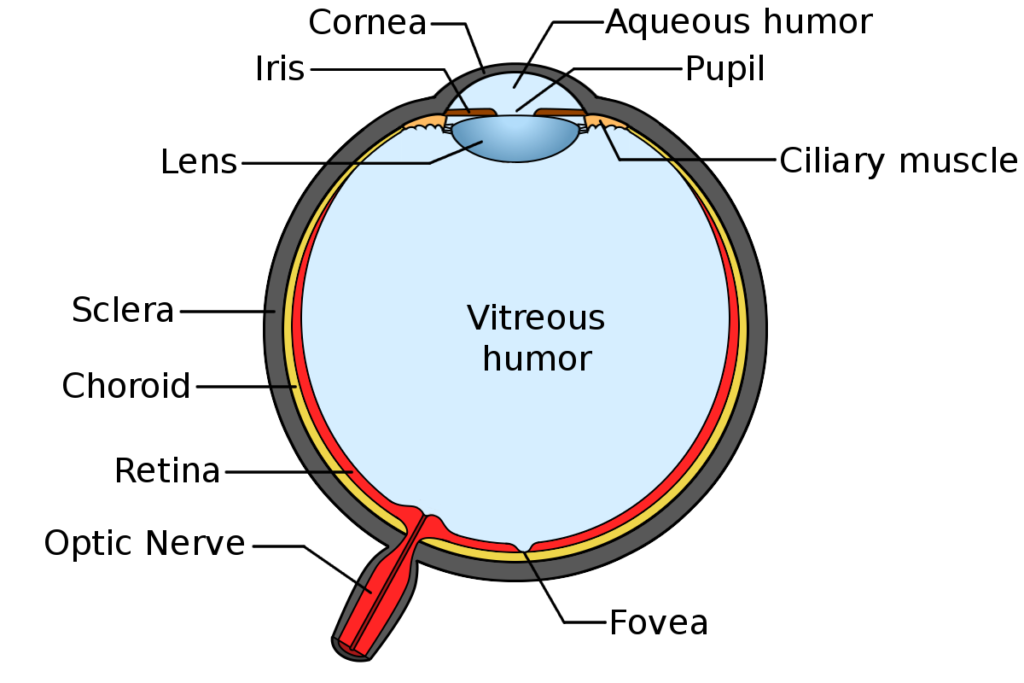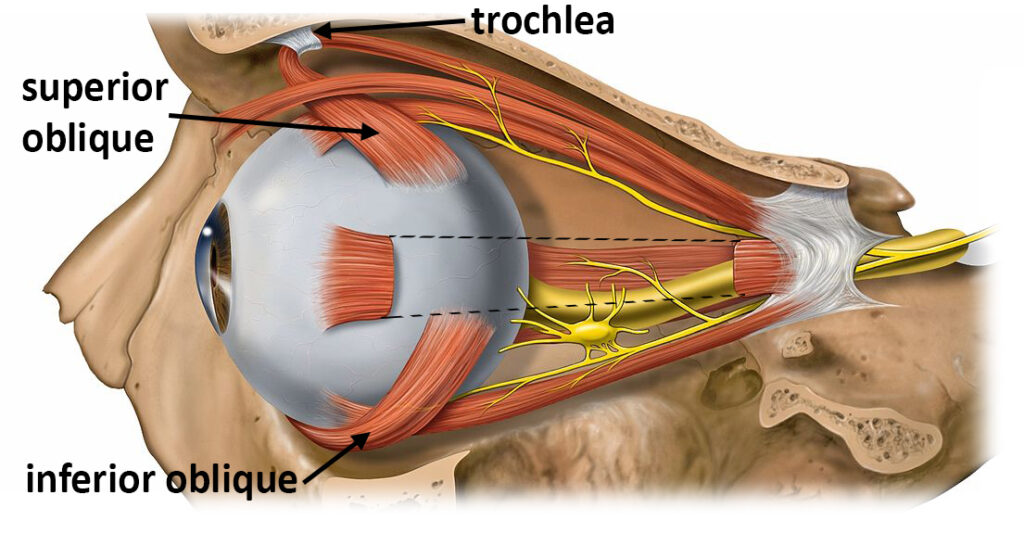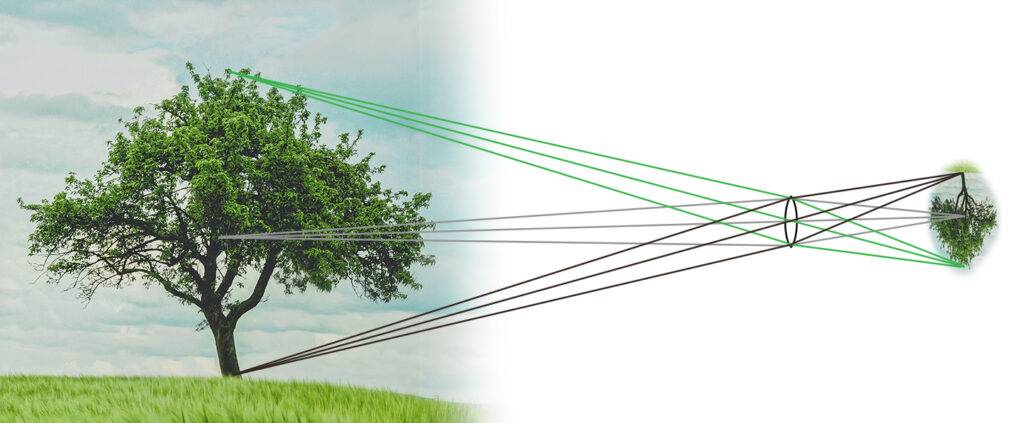I recently had the opportunity to ride in one of the newer Tesla electric cars. The dashboard had a single touchscreen which displayed a perspective view of the vehicle itself – as if seen by a bird following the vehicle by 300 feet at about 100 feet in altitude. The screen also displayed grayscale model representations of all surrounding vehicles, along with the markings on the road, the speed limit, nearby traffic lights, and other driving information. In principle, you could drive the car without ever looking out the window by looking only at the screen. Apparently, cameras surrounding the vehicle feed images into a computer which constructs a 3D virtual model of its environment, which is then displayed on the screen. In other words, it does in a very limited way what your eyes and brain do with much higher fidelity every second of your conscious life.
The ability of the human mind to construct a 3D representation of your environment based on the information sent via the optic nerve from two eyes to the brain is truly remarkable. Each part must function as designed in order for the system to work. Human vision is therefore an irreducibly complex system and cannot have evolved in a neo-Darwinian fashion. The eye was designed by God (Proverbs 20:12; Psalm 94:9).
Anatomy and Physiology
The human eye is a roughly spherical chamber filled with a transparent gel-like substance called vitreous humor. A white outer layer called the sclera surrounds the eyeball except for a small region in the front of the eye, where the transparent cornea bulges out beyond the sphere. Directly behind the cornea is the anterior chamber which is filled with a clear fluid called aqueous humor. Behind the aqueous humor are the iris and lens. The iris is the colored part of the eye which surrounds the dark pupil, and acts as an aperture adjustment which can rapidly change the size of the pupil. The lens is gel-like and can change its shape so that light from external sources comes to focus on the retina – the light sensitive surface on the back interior of the eye.

An Overview of the Retina
The retina has two types of light-detecting cells called rods and cones. These names are due to the shape of these cells. Rods are relatively long and shaped like a cylinder. Cones are shorter than rods and are indeed cone-shaped.
There are three different types of cones, each of which is sensitive to a particular range of light-frequencies. One type of cones is maximally sensitive to blue light, another to green light, and the third to red light. These three types of cones send electro-chemical signals to surrounding cells which combine the information into a signal sent to the brain which we perceive as color. Cones are therefore necessary for our ability to see color. They are primarily what we use when we read. The human eye contains about six million cones.
Rods cannot detect color because they all are equally sensitive to the same color spectrum. But they have other purposes. Rods can detect shapes and (due to the way they are connected to other cells) motion. Rods are distributed in the retina somewhat more evenly than cones, rather than being concentrated near the center of vision. So, rods are very useful in our peripheral vision. Rods also have a greater capacity to detect faint light than cones. Therefore, rods are very useful at night or in other dark conditions. The human eye contains about 120 million rods.
With a manmade camera, you generally need to choose whether you want to zoom-in on something in order to see it in great detail, or to zoom-out in order to capture a more panoramic view. The human eye basically does both simultaneously. But how can it do this without overwhelming the brain with information? The answer has to do with the way rods and cones are distributed.
The cones in particular are highly concentrated near the center of our field of view. In fact, the place on the retina that marks the center of our field of vision is packed with cones and has no rods at all. This location is called the fovea. When you look directly at something, its light falls directly on the fovea. Since there are a great many cones in the fovea, we get a very detailed view of anything directly in the center of our field of view. The ability to see small details is called visual acuity.
On the other hand, we have a lower density of light-sensing cells farther from the fovea. This is why you cannot easily read text unless you are looking directly at it. If you look away from this article, you will find that you can still see the article, but cannot read the words. The visual acuity in our peripheral vision is much lower than near our center of vision. This is how our brain avoids information overload, and yet we still have some visual knowledge of our surroundings. It is an ingenious solution.
Muscles of the Eye
In order to see something in highest detail, we need to rotate both eyes so that its light falls on the fovea of each eye. This is accomplished by six muscles attached to the external surface of the eye. Four of these muscles you can control somewhat directly. They allow you to look left, right, up, down, or any combination. These four are each attached to the annulus of Zinn behind the eye on one end, and the other end is attached to the side of the eye upon which they pull. So, to look left, the muscle on the left side of the eye flexes.
The other two muscles are the superior oblique and inferior oblique. They rotate the eyes clockwise or counterclockwise so that when you tilt your head from side to side, your eyes remain upright. You can see this by looking in a mirror, and noting the positions of the small blood vessels in the sclera (white part of the eye) as you tilt your head sideways. These muscles are also necessary to aid the vertical (the up and down) muscles in the eye since the latter are not attached at an exact 90-degree angle relative to the front of the eye.
The inferior oblique muscle is attached to the lower side of the eye, on the side that is opposite the nose. It wraps underneath the eye toward the nose, and attaches at the nasal orbital wall. When flexed, it rotates the bottom part of the eye toward the nose. The superior oblique muscle is attached to the upper side of the eye also on the side opposite the nose. But its other end attaches – not to the nasal orbital wall – but to the back of the orbit (behind the eye). So how can it rotate the eye properly? In order to pull in the right direction, the muscle is directed through a pulley called the trochlea which is attached to the upper nasal wall. The trochlea redirects the force so that when the muscle is flexed, the top part of the eye is rotated toward the nose!

I challenge any evolutionist to explain how that system could possibly have evolved. The trochlea is useless without the superior oblique muscle, and the superior oblique muscle would not pull in the correct direction apart from the trochlea. Moreover, how did the muscle evolve so that it grows already passing through the trochlea? The eye is truly a marvel of design.
When you want to look directly at something in your field of view, the six muscles of the eye flex or relax in just the right way to make it happen. Within a fraction of a second, both eyes adjust so that the image of the object of interest falls directly on the fovea of each eye. Both eyes are now aimed at exactly the same location. By analogy, imagine holding two pistols, one in your right hand and one in your left hand. Imagine being so good, that you can quick draw both guns and not only hit whatever you want, but both bullets from both guns pass through the same hole! This is essentially what your eyes are doing all the time.
3D Vision
The image that forms in the retina of your left eye is slightly different from the image in your right eye. This is because your eyes are at slightly different locations (separated horizontally by somewhere between 50 and 70 millimeters) and therefore have slightly different views of the scene. The object you are actively looking at will naturally fall directly on the fovea of each eye. But objects surrounding it will appear shifted from one eye to the other.
To see this for yourself, hold your index finger at arm’s length and focus on it. Then close your left eye. Now open your left eye while closing your right eye. As you repeat this, you will notice that the background seems to shift left and right relative to your finger. Now focus on the background and do the same experiment. This time, the background remains stationary while your finger jumps left and right. This effect is called parallax.
Your brain is able to consolidate the information produced by the slightly different images from the two eyes and interpret the result as distance for all objects in the field of view. Whether you focus on your finger or the background, the brain immediately understands that your finger is much closer than the background. For this reason, we instantly know the approximate distance of any nearby objects. We see the world in 3D. This is stereoscopic vision.
Our ability to estimate distances by parallax works best for objects within 10 feet or so, and is still somewhat effective for distances several times as much. But for very distant objects, the difference in the two images is too small to result in an accurate depth perception. Beyond such distances, the brain uses other clues such as apparent size or apparent motion to estimate distance. This all happens without conscious thought, providing you with an instant 3D mental model of your visible surroundings.
It is possible to fool our depth perception under certain circumstances. 3D movies use special glasses to send a different image to each eye, thereby replicating the sensation of depth on a flat movie screen. For distances well beyond our stereoscopic ability, other clues must be used and can sometimes be misinterpreted. For example, when the moon is high in the sky and far separated from any other reference object, the brain tends to assume that the moon is actually quite small and therefore relatively close. But when the moon first rises, the brain readily perceives that it is far more distant since it is partially obscured by trees or houses in the distance. The brain rightly concludes that the moon is more distant than those other objects, and therefore must be enormous. Many people have noticed this “moon illusion” when the moon is near the horizon. But it is only an illusion – the angular size of the moon is no bigger than when it is high in the sky.
Upside Down
One other fascinating aspect of human vision concerns the image that forms on the retina. Whenever parallel light rays pass through a convex lens, they form an image of the source at the focal point. However, this image is upside down relative to the original. Indeed, the image that forms on the retina is upside down relative to its source. Yet, we do not see the world as upside down. Why is this?

At no point does the inverted image on the retina get flipped back to its normal, upright situation. The brain simply learns how to interpret the inverted images. The brain has learned that light falling on the lower portion of the retina comes from above. It has become second nature to us, so that we correctly interpret and respond to these inverted images.
What would happen if the images on the retina were right-side-up? Scientists examined this scenario by creating “invertoscopes,” also called “upside-down glasses.” These glasses use prisms to flip all images upside down and reversed left-right. So, when a person wears these glasses, the image of any object that falls on the retina is actually correctly oriented. When an individual first puts on these glasses, the world appears upside down. But scientists have found that after one week of wearing these glasses continuously, the brain will completely adjust and the world appears right-side up! The individual can do anything he or she could do before – even ride a bike. The ability of the human brain to adjust under these circumstances is truly remarkable. When the glasses are finally removed, the brain readjusts (much more quickly) to the inverted images.
Perhaps there is a spiritual application to this strange physiological reality. In our fallen, sinful state, we view the world incorrectly. We perceive man as being the center of reality, the judge of truth and rightness, and with God constantly on trial. But this is upside down. It is the exact opposite of reality. God is the center of reality, the Judge of all truth, and man is simply a creation who will be judged by God. The Bible is like glasses that give us the true view of the universe – the proper way to perceive reality. But the unregenerate mind has become so accustomed to looking at the world upside down, that the correct, biblical worldview seems upside down to him at first.
Sinners have simply gotten so used to viewing the world upside down that it seems normal and right. Biblical truths like “love your enemy” or “the meek shall inherit the earth” seem backwards to an upside-down heart. But the Lord can turn our hearts around to love Him and know the truth. We require the help of the Holy Spirit to transform our mind, to use it properly, and to see the world as it really is.
Next, we explore color vision in part 3.

